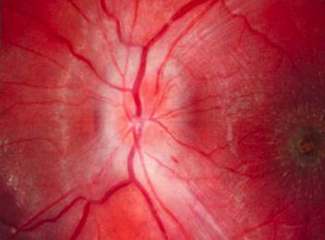- Clinical Technology
- Adult Immunization
- Hepatology
- Pediatric Immunization
- Screening
- Psychiatry
- Allergy
- Women's Health
- Cardiology
- Pediatrics
- Dermatology
- Endocrinology
- Pain Management
- Gastroenterology
- Infectious Disease
- Obesity Medicine
- Rheumatology
- Nephrology
- Neurology
- Pulmonology
A Young Woman With Sudden Loss of Vision in One Eye
A 17-year-old sexually active young woman presented with sudden loss of vision in the left eye 2 weeks before presentation.

A 17-year-old sexually active young woman presented with sudden loss of vision in the left eye 2 weeks before presentation. She denied any pain, trauma, fever, numbness, weakness, or lymphadenopathy. She had no significant past medical history but did report that she'd had a viral illness about 1 month earlier. Her family had not traveled recently and the only change in the home environment was a new kitten purchased several months ago.
The patient’s vital signs and general physical examination were normal. Ophthalmological examination revealed 20/20 vision in the right eye and hand movement vision in the left eye. There was a relative afferent pupillary defect in the left eye. The right eye exam was normal. Fundus examination of the left eye is shown in the Figure.
Laboratory investigations included a complete blood cell count, routine blood chemistries, erythrocyte sedimentation rate, and urinalysis. MRI of the brain was normal. Results of serology testing for syphilis, Lyme disease, and Toxoplasma gondii were negative. Bartonella henselae titers for IgM and IgG were 1:1024 and 1:512, respectively.
What’s Your Diagnosis?
A. Cat scratch disease–related neuroretinitis
B. Demyelinating optic neuritis
C. Papilledema
D. Anterior ischemic optic neuropathy
Answer: Cat Scratch Disease–Related Neuroretinitis (option A)
Cat scratch disease (CSD)-related neuroretinitis is caused by Bartonella henselae, a pleomorphic gram-negative intracellular bacillus. Approximately 22,000 cases of CSD are reported in the United States each year but neuroretinitis affects only 1% to 2% of infected patients.
Neuroretinitis caused by B henselae most commonly presents as unilateral painless loss of vision with optic disc edema, subretinal fluid, and eventually a partial or complete macular star figure of exudate. Retinitis, choroiditis, vasculitis, or uveitis may also be present in some cases. Viral-like symptoms (eg, malaise, fever, chills, headache, and lymphadenopathy) may precede or be associated with the visual symptoms. Contact with cats or kittens or other flea-infected animals, or a history of cat scratch or cat bite are sometimes, but not always reported.
Most cases of CSD however, are related to a feline scratch or bite, most often from a healthy kitten. The bacteria may also be present on cat fur and can be transferred through self inoculation via a mucous membrane, skin break, or conjuncitva after petting an animal. Some people who become infected do not recall being bitten or scratched by a cat. B henselae has been found in fleas and so transmission to humans may not be restricted to cats as carriers.
Thus, it is possible to have cat scratch fever without a cat, a scratch, or a fever. Classic skin lesions, fever, and lymphadenopathy are not always present in infected patients and patients with CSD may present with visual complaints only. The presence of optic disc edema with a macular star figure should prompt serologic evaluation for CSD even in the absence of the systemic signs or symptoms.
Serologic testing is helpful for diagnosis, prognosis, and to guide treatment with antibiotics. Initial investigations should include a general physical examination; an inoculation papule can be found in up to 90% of infected patients. Complete blood count and blood and serological studies for other causes of neuroretinitis (eg, syphilis, Lyme) could also be performed. Toxoplasma titers and HIV testing for high-risk individuals should also be considered.
In most patients with CSD, a single high titer (either positive IgM or IgG) is sufficient to make the diagnosis. However, in patients with an equivocal or negative acute titer, a convalescent titer for B henselae may be necessary. Neuroimaging is generally not required in patients with unilateral vision loss but should be considered in patients with bilateral vision loss or atypical disease presentations.
CSD is a self-limited and typically benign disorder; vision usually improves spontaneously over about 4 to 6 weeks. Antibiotic therapy is often recommended for patients with atypical presentations, disseminated presentation, or for immunocompromised patients, but there is little evidence of the efficacy of antibiotics for the ocular findings in typical cases of cat scratch neuroretinitis. Nevertheless, many neuro-ophthalmologists recommend treatment for serologically-confirmed disease to shorten the course and possibly improve visual prognosis. The choice of treatment regimen remains highly variable among treating physicians and there is no one specific antibiotic type, dose, or duration that has been proven and no standard of care evidence based treatment recommendation can be made at this time.
Summary Table
Condition
Characteristic features
Papilledema
Good visual acuities; optic disc swelling often bilateral and symmetric, enlargement of the blind spot on visual field testing, other signs of increased intracranial pressure
Non-arteritic anterior ischemic optic neuropathy
A swollen disc (either sector or diffuse), uncommonly associated with macular star figure of exudates. Typically occurs in vasculopathic aged patient with risk factors (eg, hypertension, diabetes, elevated cholesterol).
Cat scratch disease–related neuroretinitis
Painless, typically unilateral loss of vision, relative afferent pupillary defect with characteristic star figure of exudate; may have concomitant uveitis, history of cat exposure, confirmed with serological evidence of B henselae.
Optic neuritis
Acute, unilateral, blurred vision, associated with pain with eye movement, and loss of color vision; ipsilateral relative afferent pupillary defect, not associated with macular exudates. MRI may show demyelinating white matter lesions.
References:
For more information:
Reed JB, Scales DK, Wong MT, et al. Bartonella henselae neuroretinitis in cat scratch disease: diagnosis, management, and sequelae. Am J Ophthalmol. 1998;105:459-466.
Spoonemore KJ, McKenzie J, Raugi GJ, eds. Cat scratch disease. Medscape Reference: Drugs, Diseases, and Procedures. http://emedicine.medscape.com/article/1051992-clinical.
Accessed June 14, 2011.
